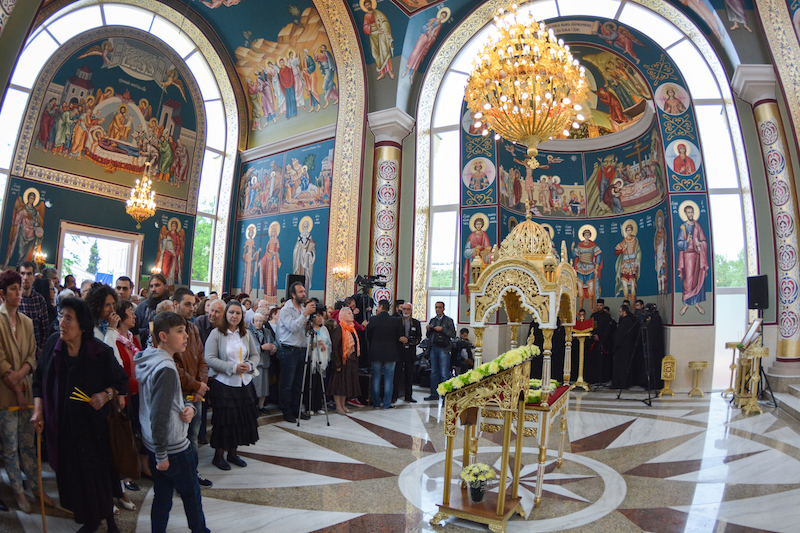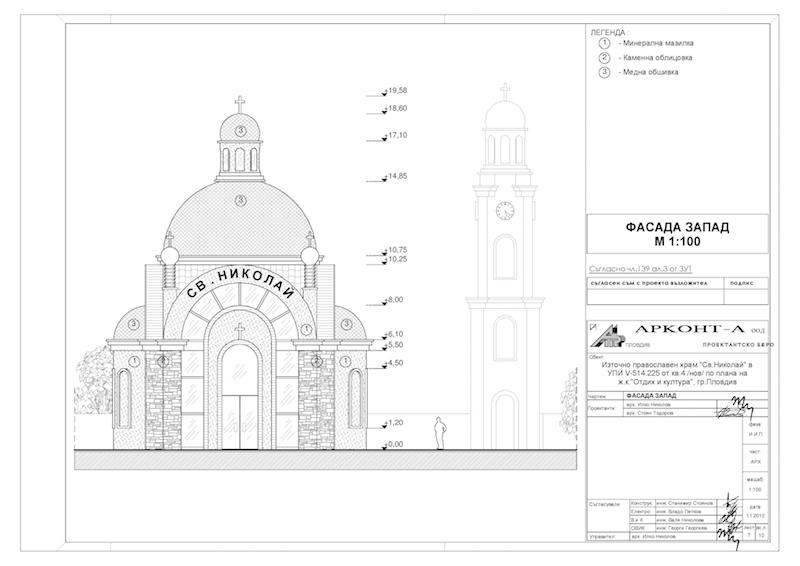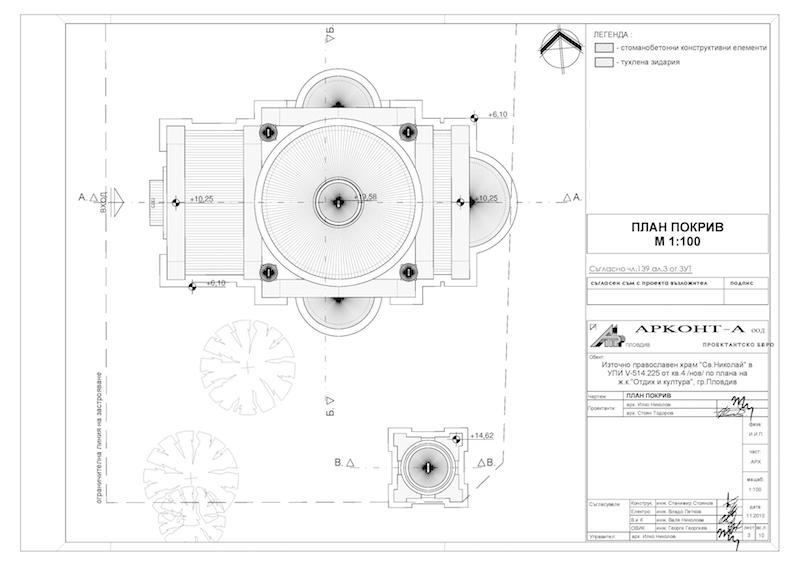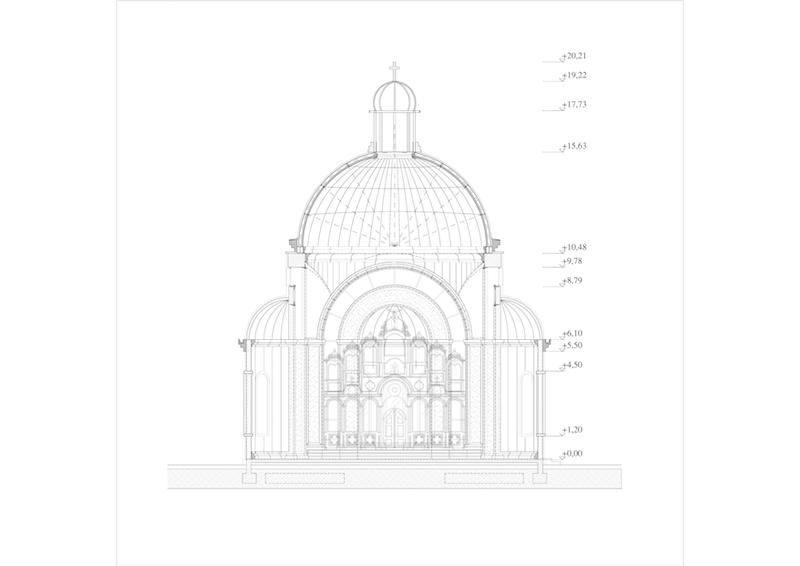In Bulgaria, Nikulden is an important winter holiday that every December 6 remembers St. Nicholas the Wonderworker, master of the underwater world and patron saint of sailors and fishermen.
Plovdiv, located in the south part of Bulgaria, is this country’s second largest city, and the oldest continuously inhabited city in Europe. Plovdiv was recently ranked among the continent’s top three destinations, and in 2019 will be Europe’s designated capital of culture.
History, religion, and culture converge at St. Nicholas the Wonderworker temple in Plovdiv, a recently completed basilica that represents the first time in Bulgaria’s long history that a temple’s construction included raising a single-nave metal dome.
Hristo Hristov, Project Manager for HMC, the construction firm that financed this project and was its general contractor and mechanical engineer, tells BD+C that the 213.6-sm (2,299-sf) building required a complex steel structure that would be flexible enough to withstand earthquake conditions, to which this part of the world is susceptible. The steel, however, is significantly lighter than building materials that have typically been used for temple construction in Bulgaria, he states.
Hristov adds that the building’s flooring was produced from four different kinds of granite.
The 22-meter-high temple is topped with the metal dome, made at HMC’s factory, that’s 5.5 meters high, 10.7 meters in diameter, and weighs 12 tons.
The history of this project, whose start and completion span from December 2010 through May 2015, “lies in a coincidence,” explains Hristov. HMC’s owner, Kiril Vasilev, was on a business trip in the Ukraine city of Nikolaev, where he happened upon, and subsequently became fascinated by, the temple of St. Nicholas there. “From that moment, Mr. Vasilev felt a strong urge to create a reproduction” in Plovdiv, says Hristov.
Based on a proposal from the Metropolitan Bishop of Provdiv Nikolay, the temple was designed and constructed 2.5 times larger than the original.
The temple is designed in the traditional Russian style, with pale yellow façade and white decorations. The primary dome is blue with golden stars, and is surrounded by smaller golden domes.
Six bells were cast for the temple, ranging in size from 30 to 200 kilograms (66 to 441 pounds).
Next to the temple is a 24-meter-high clock tower that was part of this construction project. Two-meter-high, gold-plated crosses on the tops of the tower and domes were made in the workshop of Kiev Pechersk Lavra, a historic Orthodox Christian monastery in Ukraine.
Arkont-A was the architect and structural, electrical, and plumbing engineer on the temple and tower project.
 The blue dome is surrounded by smaller golden domes. Image: HMC Construction
The blue dome is surrounded by smaller golden domes. Image: HMC Construction
 The temple was designed as a traditional Russian style. Six bells, weighing from 66 to 441 pounds, were cast for the church. Image: HMC Construction
The temple was designed as a traditional Russian style. Six bells, weighing from 66 to 441 pounds, were cast for the church. Image: HMC Construction



Related Stories
| Aug 11, 2010
10 tips for mitigating influenza in buildings
Adopting simple, common-sense measures and proper maintenance protocols can help mitigate the spread of influenza in buildings. In addition, there are system upgrades that can be performed to further mitigate risks. Trane Commercial Systems offers 10 tips to consider during the cold and flu season.
| Aug 11, 2010
IFMA announces new Religious Facilities Community of practice
The International Facility Management Association is pleased to announce the formation of the Religious Facilities Community, a new community of practice devoted to those who work as full-time, part-time or volunteer facility managers in their houses of worship. IFMA’s communities of practice are organized special interest groups that unite members of specific industries not represented by the association’s councils.
| Aug 11, 2010
AGC unveils comprehensive plan to revive the construction industry
The Associated General Contractors of America unveiled a new plan today designed to revive the nation’s construction industry. The plan, “Build Now for the Future: A Blueprint for Economic Growth,” is designed to reverse predictions that construction activity will continue to shrink through 2010, crippling broader economic growth.
| Aug 11, 2010
Report: Fraud levels fall for construction industry, but companies still losing $6.4 million on average
The global construction, engineering and infrastructure industry saw a significant decline in fraud activity with companies losing an average of $6.4 million over the last three years, according to the latest edition of the Kroll Annual Global Fraud Report, released today at the Association of Corporate Counsel’s 2009 Annual Meeting in Boston. This new figure represents less than half of last year’s amount of $14.2 million.
| Aug 11, 2010
Jacobs, HDR top BD+C's ranking of the nation's 100 largest institutional building design firms
A ranking of the Top 100 Institutional Design Firms based on Building Design+Construction's 2009 Giants 300 survey. For more Giants 300 rankings, visit http://www.BDCnetwork.com/Giants
| Aug 11, 2010
And the world's tallest building is…
At more than 2,600 feet high, the Burj Dubai (right) can still lay claim to the title of world's tallest building—although like all other super-tall buildings, its exact height will have to be recalculated now that the Council on Tall Buildings and Urban Habitat (CTBUH) announced a change to its height criteria.
| Aug 11, 2010
Divine intervention
Designed by H. H. Richardson in the 1870s to serve the city's burgeoning Back Bay neighborhood, Trinity Church in the City of Boston would come to represent the essence of the Richardsonian Romanesque style, with its clay tile roof, abundant use of polychromy, rough-faced stone, heavy arches, and massive size.







